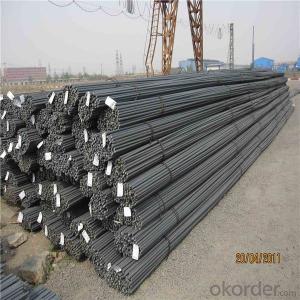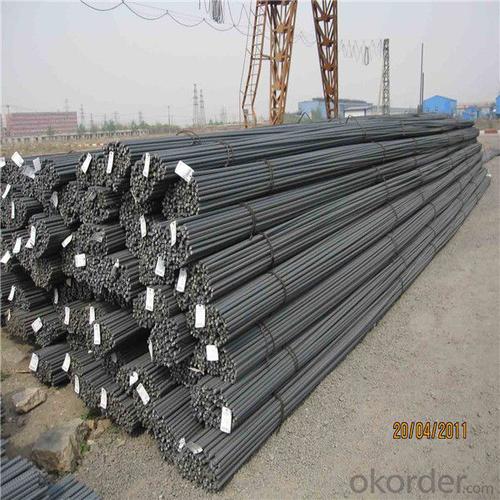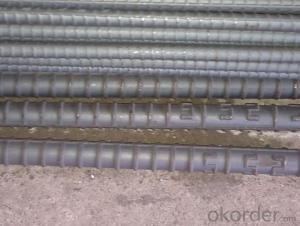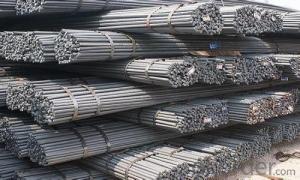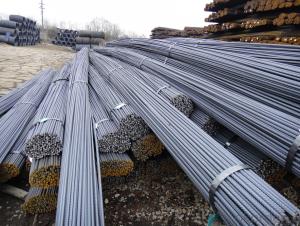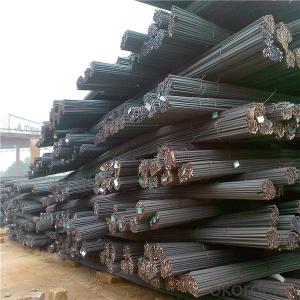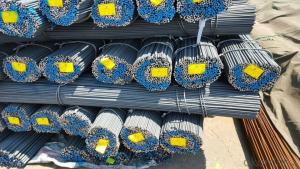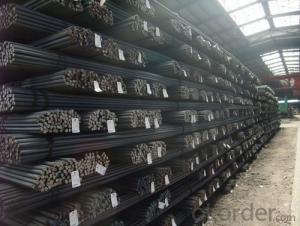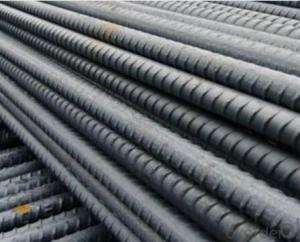Construction iron rod hot rolled for sale
- Loading Port:
- Tianjin
- Payment Terms:
- TT OR LC
- Min Order Qty:
- 1000 m.t.
- Supply Capability:
- 17497 m.t./month
OKorder Service Pledge
OKorder Financial Service
You Might Also Like
Specification
Steel rebar is bars of steel commonly used in construction, especially for reinforcing concrete structures such as driveways,
foundations, walls, and columns. These bars come in different sizes and strength grades, and can be smooth or may include
deformations that provide greater adhesion for concrete poured over the bars. When used in poured concrete, the bars are
typically placed in a grid pattern, the concrete poured over them, and then readjusted to maintain the proper shape while the
concrete sets. Steel rebar can be purchased from a number of manufacturers and is often found at construction retailers or
large hardware stores
Product Description :
Chemical composition (%): | Steel | C | Si | Mn | P | S | Ceq | ||||
HRB335 |
0.25 |
0.80 |
1.60 |
0.045 |
0.045 | 0.52 | |||||
HRB400 | 0.54 | ||||||||||
HRB500 | 0.55 | ||||||||||
Mechanical properties | Steel | Rel/ MPa | Rm/ MPa | A/ % | Agt/ % | ||||||
≥ | |||||||||||
HRB335 | 335 | 455 | 17 |
7.5 | |||||||
HRB400 | 400 | 540 | 16 | ||||||||
HRB500 | 500 | 630 | 15 | ||||||||
Package: | Standard export packing or as customer's request | ||||||||||
Application: | Construction, building, bridge, road. ect | ||||||||||
Payment terms | 1).100% irrevocable L/C at sight. | ||||||||||
Delivery time | 15-30 days after receipt of L/C or deposit by T/T | ||||||||||
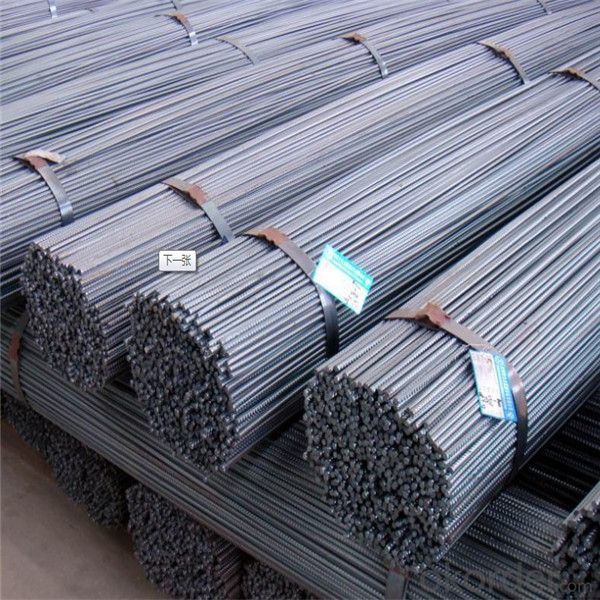
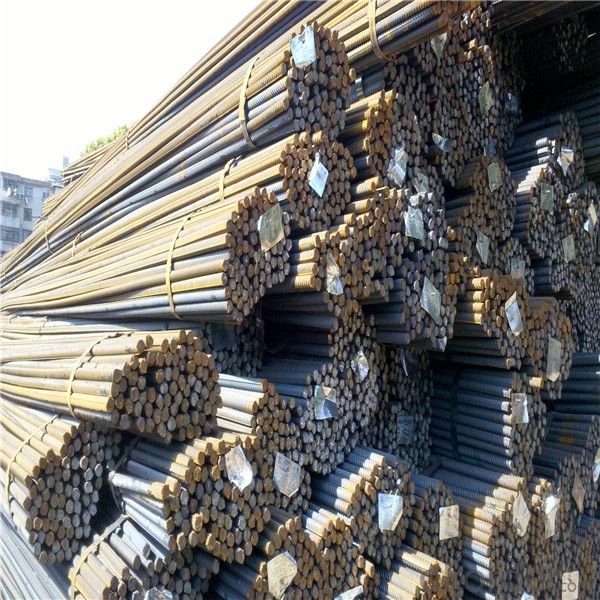
Features
1、Pure steel quality, stable chemical contents, small tolerance.
2、Constant Quality, good drawing performance.
3、High dimension accuracy degree, accuracy degree of Level C up to 80%, smooth surface, less scale, easy to be pickled.
4、Automatic bundling with 4 lines by Machine in tidy and good looks
5、Big high quality percentage, small coil percentage, and heavy coil weight for Hard Coil.
6、High sorbitizing percentage.
Packing:
In bundles, each bundle weight 3.5 tons. Load by container or by bulk verssel.
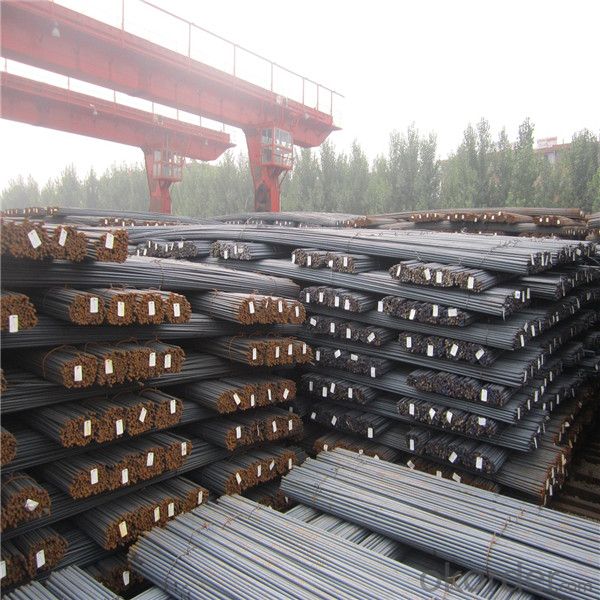

FAQ:
1.Q: What's your MOQ(minimum order quantity)?
A: One full container, mixed acceptable .
2. Q: What's your packing methods?
A: Packed in bundle or bulk ..
3. Q: How can I buy CNBM products in my country?
A:Please send us an inquiry or email ,we will reply to you if there is distributor in your country
4. Q: Can we visit your factory?
A: Warmly welcome. Once we have your schedule, we will arrange the professional sales team to follow up your case.
5. Q: How long does it take to get the product if i place an order?
A:With the process of your requirements,we will pack and deliver in 3-7 days. If it is by sea shipment,it will take 15-45 days depending on different locations
- Q: Can steel rebars be used in retrofitting existing structures?
- Yes, steel rebars can be used in retrofitting existing structures. They are commonly employed to enhance the strength and stability of buildings, bridges, and other infrastructure. By reinforcing the existing concrete or masonry elements, steel rebars help improve their load-carrying capacity and resistance to various forces, such as seismic activity or increased loads. This makes them an ideal choice for retrofitting projects, ensuring the safety and longevity of existing structures.
- Q: Can steel rebars be used in tunnel boring machine (TBM) construction?
- Yes, steel rebars can be used in tunnel boring machine (TBM) construction. Steel rebars are commonly used to reinforce concrete structures, including tunnels built using TBM technology. The rebars provide additional strength and stability to the concrete lining, ensuring the structural integrity of the tunnel.
- Q: Is thread steel rod or wire?
- Bars: straight steel bars of circular diameter, six angles, square or other special-shaped shapes. In stainless steel, the majority of bars generally refer to round steel.Wire rod refers to the hot-rolled steel bar of 5-22mm diameter or the special-shaped steel of this section. As a result of wire rod delivery, it is also known as wire rod.
- Q: What is the role of steel rebars in preventing cracks in concrete structures?
- Steel rebars play a crucial role in preventing cracks in concrete structures by providing reinforcement and enhancing the overall strength and durability of the concrete. When concrete is poured, it is initially strong in compression but weak in tension. This means that concrete can withstand forces that push or compress it, but it is prone to cracking when subjected to pulling or tension forces. To counteract this weakness, steel rebars are embedded within the concrete. These rebars act as a framework, distributing and absorbing tensile forces that would otherwise cause cracks in the concrete. When the concrete experiences tension, the rebars bear the load and help redistribute the forces, preventing cracks from forming or spreading. The steel rebars also enhance the structural integrity of the concrete by increasing its resistance to bending, shear, and other types of stress. This reinforcement is particularly important in large concrete structures such as buildings, bridges, and dams, as it helps to ensure their stability and longevity. Additionally, steel rebars also play a critical role in preventing cracks in concrete due to temperature changes and shrinkage. Concrete tends to expand and contract with temperature fluctuations, and this can lead to cracking if not properly controlled. Steel rebars help to control these movements by providing restraint and minimizing the potential for cracks. Overall, the presence of steel rebars in concrete structures significantly improves their ability to resist cracking. They reinforce the concrete, enhance its tensile strength, and help distribute and control forces that may cause cracks. By effectively preventing cracks, steel rebars contribute to the long-term durability and safety of concrete structures.
- Q: How are steel rebars used in the construction of tunnels and underground passages?
- Steel rebars are used in the construction of tunnels and underground passages to reinforce the concrete structures. They are embedded within the concrete to increase its strength and prevent cracking or collapsing under the pressure exerted by the surrounding soil or water. The rebars provide structural integrity and durability, ensuring the tunnels and passages can withstand the forces and stresses they encounter.
- Q: How do steel rebars affect the bond strength between concrete and reinforcement?
- Steel rebars play a crucial role in enhancing the bond strength between concrete and reinforcement. The presence of rebars in concrete structures creates a mechanical interlock between the two materials, resulting in a stronger and more durable bond. Firstly, rebars provide a larger surface area for the concrete to adhere to. The rough texture of the steel surface allows the fresh concrete to bond effectively, creating a strong bond. This increased surface area also helps to distribute loads more evenly, reducing stress concentrations and enhancing the overall structural integrity of the concrete. Secondly, rebars act as a load transfer medium, transmitting forces between the concrete and reinforcement. As the concrete experiences tensile forces, which it is inherently weak in resisting, the rebars bear these forces and effectively carry them across the concrete-rebar interface. This prevents cracks from propagating and helps to maintain the overall stability and strength of the structure. Moreover, the presence of rebars helps to control cracking in concrete. As the concrete undergoes shrinkage or temperature variations, it tends to crack. However, with the presence of rebars, these cracks are restricted or minimized. The rebars act as reinforcement, holding the concrete together and preventing crack propagation. Additionally, steel rebars improve the bond strength by providing anchorage. The embedment of rebars into the concrete creates a mechanical connection, preventing the rebar from slipping or pulling out. This anchorage ensures that the bond between the concrete and reinforcement remains intact, even under high loads or external forces. In summary, steel rebars significantly enhance the bond strength between concrete and reinforcement. They provide a larger surface area for adhesion, act as load transfer mediums, control cracking, and offer anchorage, ensuring a stronger and more durable bond. Their presence contributes to the overall stability and longevity of concrete structures.
- Q: Can steel rebars be used in the construction of offshore wind farms?
- Yes, steel rebars can be used in the construction of offshore wind farms. Steel rebars are commonly used in reinforced concrete structures, providing strength and durability. In offshore wind farms, where structures are exposed to harsh environmental conditions, steel rebars are essential for reinforcing foundations, substructures, and other concrete components. They help ensure the stability and integrity of the offshore wind farm structures, making steel rebars a vital material in their construction.
- Q: Can steel rebars be used in the renovation of historic structures?
- Yes, steel rebars can be used in the renovation of historic structures. Steel rebars are commonly used in construction projects to provide reinforcement and increase the structural integrity of buildings, including historic structures. When renovating historic structures, it is essential to maintain the original character and integrity of the building while ensuring its stability and safety. Steel rebars can be strategically placed in the renovation process to reinforce weak areas, strengthen load-bearing elements, and extend the lifespan of the structure without compromising its historical value. However, it is crucial to work with experienced architects, engineers, and preservationists who are knowledgeable in historic preservation to ensure that the use of steel rebars is done in a way that respects the original design and materials of the historic structure.
- Q: What is the difference between hot-rolled and cold-rolled steel rebars?
- The main difference between hot-rolled and cold-rolled steel rebars lies in the manufacturing process. Hot-rolled steel rebars are formed by heating the steel billet to high temperatures and then passing it through rollers to shape it into the desired rebar size. This process results in a rougher surface and less precise dimensions. On the other hand, cold-rolled steel rebars are manufactured by cooling the steel billet and then passing it through rollers at room temperature. This process produces a smoother surface and more accurate dimensions. Overall, the choice between hot-rolled and cold-rolled steel rebars depends on the specific application and the desired properties of the rebar.
- Q: What is the role of steel rebars in industrial construction?
- The role of steel rebars in industrial construction is to provide reinforcement and strength to concrete structures. They are used to prevent cracking and increase the load-bearing capacity of the construction.
Send your message to us
Construction iron rod hot rolled for sale
- Loading Port:
- Tianjin
- Payment Terms:
- TT OR LC
- Min Order Qty:
- 1000 m.t.
- Supply Capability:
- 17497 m.t./month
OKorder Service Pledge
OKorder Financial Service
Similar products
Hot products
Hot Searches
Related keywords
